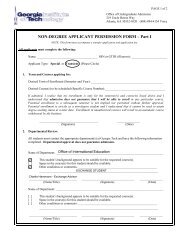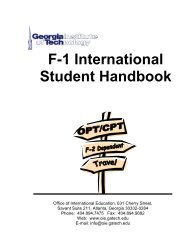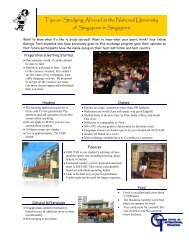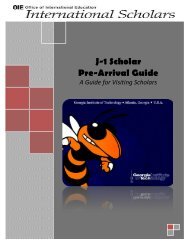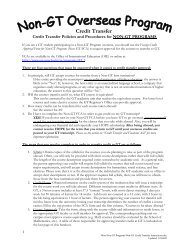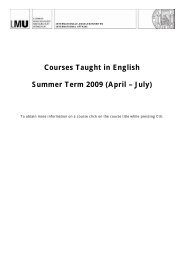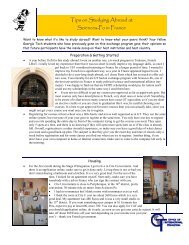tips for study abroad Lund - Office of International Education
tips for study abroad Lund - Office of International Education
tips for study abroad Lund - Office of International Education
Create successful ePaper yourself
Turn your PDF publications into a flip-book with our unique Google optimized e-Paper software.
Tips on Studying Abroad at<br />
<strong>Lund</strong> University in Sweden<br />
Want to know what it’s like to <strong>study</strong> <strong>abroad</strong>? Want to know what your peers think? Your fellow<br />
Georgia Tech students who have previously gone on this exchange program gave their opinions so<br />
that future participants have the inside scoop on their host institution and host country.<br />
Preparation & Getting Started<br />
• There will be an orientation and<br />
welcome reception once you arrive<br />
at <strong>Lund</strong>.<br />
Housing<br />
• Dorms house international students<br />
and are the center <strong>of</strong> the social<br />
scene.<br />
• When I applied <strong>for</strong> housing I was<br />
not familiar with any <strong>of</strong> the residence<br />
halls– so I really just applied<br />
based on word <strong>of</strong> mouth.<br />
• I lived in Sparta– located right next<br />
to the Design Centrum.<br />
• I did not have any roommates, but I<br />
shared a communal kitchen with<br />
many residents– a great way to get<br />
to know your corridor mates!<br />
• There is a kitchen in the dorm.<br />
Classes<br />
• If you’re going to <strong>study</strong> Industrial Design, the courses include guest speakers<br />
from European companies (such as Volkswagen), and class presentations to<br />
Swedish government <strong>of</strong>ficials (such as the Minister <strong>of</strong> Sustainable Development).<br />
You also tour facilities and work on projects <strong>for</strong> real companies.<br />
• Classes are long: sometimes 8a-5p or 8a-3p.<br />
• Industrial Design students have different and advanced types <strong>of</strong> tools available<br />
<strong>for</strong> their use in the studios.<br />
• There is a lot <strong>of</strong> group work.<br />
• Pr<strong>of</strong>essors and advisors are friendly and approachable.<br />
• The studio size was pretty small. There were about 20 Swedish students and<br />
7 <strong>International</strong> students<br />
• The pr<strong>of</strong>essors love <strong>International</strong> students!<br />
• I loved the diversity– it was probably the best thing about the educational<br />
experience.<br />
• You take one class at a time so there is less overlap and the work load seems<br />
easier.<br />
• I took studio, two Design electives and Materials <strong>study</strong>. They were nice because<br />
there are no lecture classes– it is mostly instruction and free work time.<br />
• The grades are all based on ef<strong>for</strong>t.<br />
• When it comes to homework and exams, they don’t really exist. Studio time<br />
is basically used how you see fit.I chose this program because I was able to<br />
take studio <strong>abroad</strong> and Sweden has a very interesting design perspective.<br />
• I signed up <strong>for</strong> courses while I was in the US, but once you get to Sweden,<br />
the schedule is pretty much set <strong>for</strong> you.<br />
• Your schedule is pretty much pre-defined by what year you are in studio.<br />
Communication<br />
• Cell phones can be used <strong>for</strong> calling or sending<br />
text messages.<br />
• I would recommend getting a pre-paid cell<br />
phone to take so you can call friends who are<br />
with you on the trip<br />
• I used Skype to keep in touch with everyone<br />
at home<br />
• Definitely bring your laptop– Housing will<br />
have internet <strong>for</strong> you.<br />
Food<br />
• You can shop at ICA, a popular grocery store, and cook meals in the<br />
dorm kitchen. There are a lot <strong>of</strong> international<br />
students, so it’s fun to try foods<br />
from all <strong>of</strong> the different countries that are<br />
represented.<br />
• The 40 SEK pizzeria is a good choice <strong>for</strong><br />
cheap pizza.<br />
• “Sittning” is a traditional three-course<br />
meal consisting <strong>of</strong> meat, potatoes, and<br />
tomatoes.<br />
• The Design Centrum had a great café, but<br />
it became expensive to eat there <strong>of</strong>ten.<br />
• Generally eating out is going to be pricey—cooking<br />
your own food is much more cost effective.<br />
• I had a great time learning to cook Swedish food.<br />
*These comments do not reflect the views <strong>of</strong> GT’s <strong>Office</strong> <strong>of</strong> <strong>International</strong> <strong>Education</strong>. They are based on<br />
students’ individual opinions and are, there<strong>for</strong>e, not necessarily representative <strong>of</strong> all student experiences.
Transportation & Travel<br />
• You can rent a bike <strong>for</strong> getting<br />
around the town.<br />
Lifestyle<br />
• You can join a “nation”, which is a social organization similar to<br />
a fraternity.<br />
• It is very easy to meet and be friends with Swedish students, as<br />
well as with the other exchange students.<br />
• There is decent nightlife in town.<br />
• I had no problem finding things to do and people to meet.<br />
• Doing things with a mentor group is fun– and a great way to get<br />
to know other students (international and Swedish).<br />
• I did not learn the language– all Swedes speak decent English.<br />
Cultural Differences<br />
• The biggest adjustment <strong>for</strong> me was daylight time.<br />
• The Swedish students were friendly, but it did take a while <strong>for</strong><br />
them to feel com<strong>for</strong>table around Americans.<br />
• I had to re-learn how to ride a bike– that was probably the biggest<br />
adjustment I had to deal with!<br />
Finances<br />
• The only money I spent that was beyond<br />
what I would spend in a normal<br />
semester was <strong>for</strong> weekend travels<br />
around Europe.<br />
• Conversions can be tricky, so be sure<br />
and keep a close eye on all that you<br />
are spending.<br />
• Credit cards are probably the most<br />
convenient thing to have– just be<br />
sure and keep an eye on the extra<br />
charges.<br />
Packing<br />
• During the fall, it is <strong>of</strong>ten<br />
rainy and cold, so pack accordingly.<br />
• Be sure to pack warm and<br />
pack light!<br />
• Don’t <strong>for</strong>get a warm, water<br />
and wind-pro<strong>of</strong> jacket and<br />
water-pro<strong>of</strong> shoes<br />
Participant Pr<strong>of</strong>iles<br />
Please see in<strong>for</strong>mation <strong>of</strong> contributing students below. If a blog or website is<br />
listed, feel free to take a look! Also, if an e-mail address is listed, you may<br />
contact that student if you have any questions about their <strong>study</strong> <strong>abroad</strong> experience.<br />
John Chin, ID, Fall 2006<br />
johnnychin.blogspot.com<br />
Stephen Kennedy ID 2007<br />
S.k@gatech.edu




